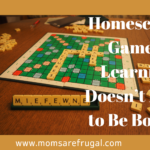What better way to lear Biology than with a game of survivor? I love to teach with games. They are an easy way to enhance any curriculum. I first learned this when my oldest was in middle school. Hard to learn math concepts came easier when I related them to a game.
This was reiterated when my third son went to speech class, and they were playing games. He graduated in five years, and hasn’t had to go back. Games solidify the knowledge and concepts we want our homeschoolers to remember.
Here is how I play Biology, Survivor style:

Survivor Island and Teams
First, we choose the teams. Second we choose the topics, and third we formulate the challenges. Some are physical, some are mental. Puzzles are included, but they are a little easier because, well they are kids. Topics to choose from are: ecosystems, human body, cells, plants, environmental science, food chains, and animal adaptations.
We played this with our co-op and that made it easier with more kids. After separating the teams have each team choose a bandana, or make signs to differentiate them from the other team. If you have time you can let them make flags, or they are fine to leave that part out.
Finally, set up stations around the area you will be playing. If it is outside, set them up far enough apart that one team cannot see the other team. The stations will represent the challenges.
Biology Topics and Challenges
The best way to learn biology is to set up the game with easy to understand topics and challenges. For example, ecosystems will be taught by putting the organisms in order. Teach the human body by putting one together (a puzzle maybe) and labeling the different parts.
Another topic is where the tribes will learn animal adaptations by identifying traits that help them survive in their environment. Likewise, plants and photosynthesis can be taught by matching plant parts. Playing the game of survivor to learn biology will seal in this information for them to remember when they are out of homeschool. Which, is what we want. The idea is to teach to learn, not spew out facts.
Another fun way to teach with this game is to change the locations. I named the one that I am doing with homeschoolers’ “The Arctic Expedition”. In the spirit of keeping the game low cost, a lot of the challenges and other aspects of the game can be made with items from home. Use index cards for matching, and magazines for animal adaptations.
Enhance Teamwork and Communication
Teamwork and communication are key traits to have as an adult. Learning these traits as children creates the habit to carry forward into adulthood. Not only will they learn biology, but being separated and working through challenges helps with overall cooperation.
Working with others’ in a productive manner is a top priority in the working world. Everyone is not always agreeable, and I tell this to my teams’. It is important to note that some may want to avoid working together so they get the win. But, in my homeschool survivor game it is not one winner, but a team effort.
Once the game has begun, allow them to work through all of the rotations and biology topics. When this is done leave fifteen minutes to hold tribal council trivia.
Review Topics and Learning Rewards
Use the end of the game, or “tribal council” as a review session. Set up trivia questions and have rewards. I don’t do monetary rewards, but as a team whomever gets the most points during trivia wins. Homeschoolers love to play trivia. At the end of the game make sure to have a quick Q&A session asking them what they liked and did not like to be able to tweak the game for the next learn biology session.
This drives home the intent of learning and future biology expeditions via the survivor game. Also, it is an affordable way to teach with low cost and high fun. For more frugal homeschooling games, tips and more sign up for my newsletter. Im on Instagram @momsarefrugal.








Leave a Reply